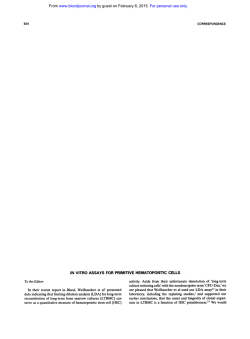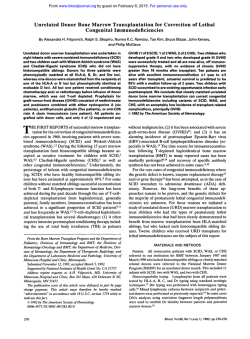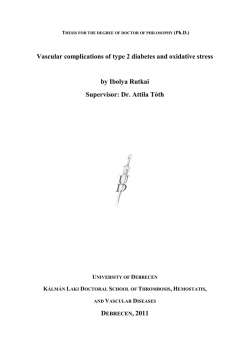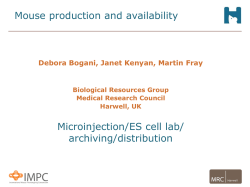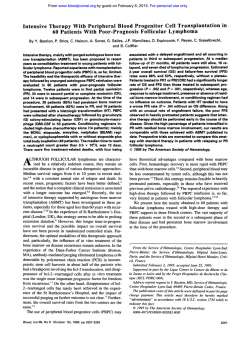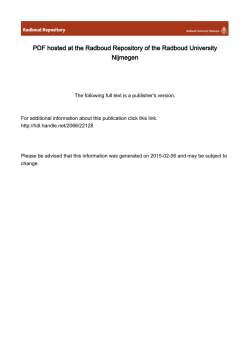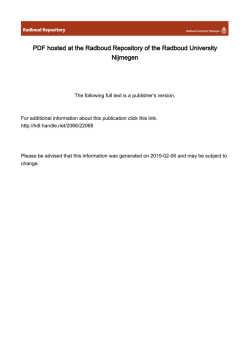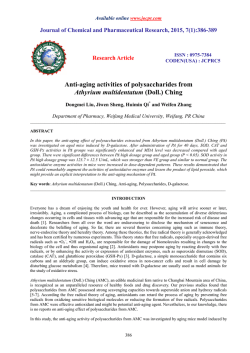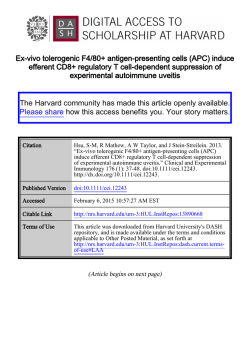
The Role of Granzyme B in Murine Models of Acute Graft
From www.bloodjournal.org by guest on February 6, 2015. For personal use only. RAPID COMMUNICATION The Role of Granzyme B in Murine Models of Acute Graft-Versus-Host Disease and Graft Rejection By Timothy A. Graubert, John H. Russell, and Timothy J. Ley A complete molecular description the of syndromes of graftversus-host disease (GVHD) and graft rejection could have a significantimpact on clinical bone marrow transplantation. Recent in vitro experiments (Heusel et al. Cell 76977, 1994 and Shresta et al. Proc Natl Acad Sci USA 92:5679, 1995) have shown that the putative mediators of these two syndromes, cytotoxic lymphocytes(CTL) and natural killer (NK) cells, respectively, initiate program a cell of death (apoptosis) in susceptible target tissues in a manner critically dependent on the serine protease Granzyme B (gzm B). In the present study,we have analyzedthe phenotype of gzm B-deficient mice using experimental transplant models designed to isolate their CD8' CTL, CD4+ CTL, and NK com- partments. We found a significantimpairment in class I-dependent GVHD mediated by gzm B -/- CD8' CTL, whereas class Il-dependent GVHD was not altered using gzm B -/CD4' effectors. In ahybridresistancemodel, gzm B -/hosts rejected haplo-identical marrow grafts as efficiently as did their wild-type littermates. This result is surprising in light of a severe defectin the ability of gzm B -/- NK cells to induce apoptosis in susceptible targets in vitro. These in vivo data define a significant role for gzm B in cytotoxicity mediated by CD8' CTL, but not by C54+ CTL. Furthermore, these resultsdo not support amodel of hybrid resistancein which NK cells play a pivotal role. 0 1996 by The American Society of Hematology. G In vitro analysis of immune effector cells from mice bearing a null mutation in the gzm B locus has shown profound functional defects. In standard lytic assays, gzm B-deficient CD8' CTL and lymphokine-activated killer (LAK) cells exhibit a severe defect in theirability to rapidly induce apoptosis in allogeneic target cells, but late cytotoxicity recovers In contrast, gzm B-deficient NK cells cannot induce apoptosis in target cells despite high effector:target ratios or prolonged incubation times.' The Chbdiak-Higashi Syndrome, an inherited disorder of humans resulting in increased susceptibility to infections, provides independent confirmation of the critical importance of the granule exocytosis pathway for CTL- and NK-mediated cytotoxicity. CTL, NK cells, and neutrophils from these patients share a common defect in granulopoiesis. The primary and secondary granules fuse aberrantly; consequently, the lytic contents cannot be delivered to a target cell.' AIthough Chkdiak-Higashi CTL still exhibit some cytotoxicity, Chbdiak-Higashi NK cells are virtually devoid of cytotoxicity.' Mice homozygous for the beige mutation have a similar phenotype." These observations support the conclusion drawnfromthe analysis of perforin and gzm B-deficient mice that the granule exocytosis pathway is important for CTL cytotoxicity and essential for NK cytotoxicity. Murine transplant models developed inthe 1980s dissected the roles of CD4' and CD8' CTL in the pathogenesis of GVHD.I"l3 Congenic strains of C57BW6 mice expressing either a mutant class I (B6.C-H-2b'"l) or class I1 (B6.C-H2b""2)allele served as hosts for these experiments. These mice were reconstituted after lethal irradiation with syngeneic marrow combined with purified T-cell subsets from the partially mismatched parental strain (BL/6, H-2b).After alloattack by T cells on the marrow graft, the hosts succumbed as a result of marrow aplasia at day 10 to 14 (in the case of a class I mismatch) or day 20 to 24 (class 11 mismatch) post-BMT. These results indicated that single antigen H-2 mismatches that provoke either class I- or class 11-restricted responses canleadto100%mortality from acute GVHD when as few as IO5 donor-derived T cells are infused. The cellular basis of the host-versus-graft (ie, rejection) response has not beenas well characterized. The prototypical RAFT-VERSUS-HOST disease (GVHD) and graft rejection remain significant obstacles for successful allogeneic bone marrowtransplantation (BMT). The molecular programs used by the immune effector cells responsible for these clinical syndromes, cytotoxic lymphocytes (CTL) and natural killer (NK) cells, are a subject of intense investigation. One manner in which these cells mediate tissue destruction is by direct contact-dependent cytotoxicity, resulting in apoptotic death of the target cell. The granule exocytosis pathway is probably the most important apoptotic mechanism used by CD8' CTL and NK cells. In this model, the recognition and tight binding of a susceptible target cell by a CTL or NK cell causes vectorial alignment of their secretory apparatus, promoting delivery of electron dense cytoplasmic granules to the target cell membrane at areas of close intercellular contact.' One granule constituent is perforin, a proteinthat undergoes calcium-dependent polymerization on the target cell membrane, forming a complement-like lesion through whichother granule constituents, including the granzymes, probably enter the target cell cytoplasm.' The delivery of the granule component proteins, including granzymes A and B, is required for induction of apopto~is.~.~ Granzyme B (gzm B), a neutral serine protease that cleaves substrates with aspartic acid at the P1 site,' is essential for the rapid induction of this apoptotic pathway. From the Division of Bone Marrow Transplantation and Stem Cell Biology, the Departments of Internal Medicine and Genetics, and the Department of Molecular Biology and Pharmacology. Washington University Medical School, St Louis, MO. Submitted November 6, 1995; accepted November 27, 1995. Supported by National Institutes of Health Grants No. CA49712, DK49786, und DK38682 and the Washington University-Monsanto agreement. Address reprint requests to Timothy J. Ley, MD, Washington University Medical School, Campus Box 8007, 660 S Euclid Ave, St Louis. MO 63110. The publication costsof this article were defrayedin part by page chargepayment. This article must therefore behereby marked "advertisement" in accordance with I8 U.S.C. section 1734 solely 10 indicate this fact. 0 1996 by The American Society of Hematology. 0006-4971/96/8704-0049$3.00/0 1232 Blood, Vol 87,No 4 (February 15). 1996:pp 1232-1237 From www.bloodjournal.org by guest on February 6, 2015. For personal use only. 1233 GRANZYME B IN GVHDAND GRAFT REJECTION host-versus-graft reaction is rejection of parental marrow by the F1 progeny of two inbred strains (a -+ a X b), a phenomenon knownas hybrid resistance.I4.l5Recent transgenic experiment~'~." support the notion that the effector cell mediating hybrid resistance lyses target cells that do not display the full complement of self histocompatibility determinants (the missingselfhypothesis).18Circumstantialevidencefavors the NK cell as the likely mediator of hybrid resistan~e,'~-~' although definitive proof of this is not yet available. We performed the present study to analyze the contribution of gzm B to cytotoxicity mediated by CTL and NK cells in vivo using these established murine models of acute GVHD and hybrid resistance. Our results suggest that gzm B plays a significant role in acute GVHD mediated by CD8+, but not CD4+ CTL. In contrast, gzm B does not appear to be essential for hybrid resistance. In view ofthe critical role of gzm B for in vitro NK cytotoxicity, this finding suggests that NK cells are not required for hybrid resistance. MATERIALS AND METHODS Mice. gzm B-deficient mice were derived in a C57BL/6 X 129/ Sv background, as previously described! Heterozygote crosses yielded littermates genotypically -I- or +I+ at the gzm B locus, determined by Southern blot analysis of tail DNA.'B6.C-H-2b"", B6.C-H-2bm'Z,Balbk, CBA/J, and 129/SvJ mice were obtained from the Jackson Laboratory (Bar Harbor, ME). Acute GVHD model. Lymphocytes were isolated from the mesenteric lymph nodes of 8- to 12-week-old gzm B +I+ or -I- sexmatched littermate donors by passage through a stainless steel mesh. T-cell subsets were then prepared, as previously described." In brief, antibody-mediated complement lysis was performed by adsorbing antibodies to B cells (monoclonal antibody [MoAb] J1 Id) and CD4' cells (MoAb RL.172) or CD8' cells (MoAb 3.155) at 4°C for 30 minutes at a concentration of lo7 IymphocyteslmL in RPM1 1640 (Sigma, St Louis, MO) supplemented with 5% (vol/vol) heat-inactivated fetal calf serum, 1 mmol/L sodium pyruvate, 15 mmol/L HEPES, 2 mmol/L I-glutamine, nonessential amino acids at 0.1 moll L each, 25 U/mL penicillin, 25 pg/mL streptomycin, and 75 pmoV L /3-mercaptoethanol. The lymphocytes were then incubated at 37°C for 1 hour in the presence of complement (rabbit Low-Tox-M; Cedarlane Laboratories, Hornby, Ontario, Canada). T cells were recovered by centrifugation through a 1.119 g/mL Histopaque gradient (Sigma), washed twice in complete media before counting (>95% viable by Trypan blue exclusion), and combined at a dose of 1.0 X lo6 cells with the marrow graft before infusion. Unpooled T cells derived from single donors were used in all transplants, except for the fully allogeneic experiments. Bone marrow grafts were prepared from the hosts by flushing both femora with 1 mL of 1 X Hebs (20 mmol/L HEPES, pH 7.05, 137 mmol/L NaCI, 5 mmol/L KCI, 0.7 mmol/L Na,HPO,; 6 mmoV L dextrose) through a 22-G needle. After settling debris, cells were washed once in phosphate-buffered saline (PBS) and counted. A dose of 2 X IO6 viable nucleated marrow cells was combined with the T-cell graft in a volume of 450 pL of PBS and infused via a lateral tail vein. Hosts were conditioned with gamma irradiation from a "'CS source at a rate of 95.2 cGylmin 24 hours before transplantation. Balb/c hosts received 700 cGy, whereas the bml x 129 and bm12 X 129 hybrids received 1,OOO cGy. Animals were housed in a pathogen-free barrier facility in a manner approved by the Animal Investigation Committee at Washington University. Mice were observed daily and killed if moribund or unable to take food. Hybrid resistance model. gzrn B -1- or +I- (H-2bk)F2 hybrid hosts (identified by Southern blot analysis of tail DNA and immunophenotyping of peripheral blood) were conditioned with 800 cGy 24 hours before intravenous (IV) infusion of 6 X 10' nucleated marrow cells prepared from BL/6 X 129 (H-2b) donors. Engraftment was measured at day +5 by the method of Bennett et al.', In brief, each animal received a single injection of 10" m o w 5-flouro-2'deoxyuridine (to inhibit endogenous thymidylate synthetase) intraperitoneally (IP) followed 1 hour later by0.5 pCi '''IUdR (ICN Biomedicals, Costa Mesa, CA) in 0.03 m o m citrate. Eighteen hours later, the animals were killed and splenic incorporation of '%JdR was measured in a gamma counter. Splenic uptake of the label, an index of engraftment, was calculated by the following formula: [(Spleek,,, - Mock Transplant Spleen,,,)/O.5 pCi dosecpm]X 100. In a second series of experiments, gzm B -/- or +I- F2 hybrid hosts received a single neutralizing dose (250 pg IP) of monoclonal ) ~antimouse ~ y interantimouse tumor necrosis factor a ( T N F ~or feron (yIFNZ5;both provided byDr R Schreiber, Department of Pathology, Washington University, St Louis, MO) 24 hours before transplantation. The remainder ofthe protocol was performed as discussed above. H-2 immunophenotyping. One hundred microliters of whole blood was obtained from the retro-orbital sinus of an anesthetized animal. After 10 minutes of incubation at 4°Cin redblood cell (RBC) lysis buffer (150 mmol/L NH,Cl, 10 mmol/L KHCO,, 0.1 mmol/L Na2EDTA, pH 7.1-7.4), the nucleated cells were washed twice in PBS and resuspended in serum-free media. Cells (IO') were stained with fluorescein isothiocyanate (FITC) antimouse H-2Kband phycoerythrin (PE) antimouse H-2K' (Pharmingen, San Diego, CA) and analyzed on a FACScan (Becton Dickinson Immunocytometry Systems, San Jose, CA). Statistics. Survival after BMT in the GVHD model was analyzed by the Kaplan-Meier method.26 The groups were compared using Log-Rank analysis. The Mann-Whitney test was used to compare engraftment among the experimental groups in the hybrid resistance model. RESULTS Acute GVHD model: CD8+ CTL. A single antigen class I mismatch acute GVHD model was created using (bml X 129) F1 miceas hosts. These F1 hybrids share all minor histocompatibility loci with the gzrn B (BW6 X 129) T-cell donor, ensuring thattheonlyallogeneicstimulusderives from the mutant H-2b"'1 (class I) allele. Balb/c (H-zd) mice, mismatched at all major and minor loci relative to the gzm B mice, served as hosts in the fully allogeneic acute GVHD model. The experimental design involved conditioning the hosts with lethal irradiation and then rescuing them with an infusion of syngeneic marrow from a sex-matched littermate. gzm B +/+ or -/-, CDCdepleted, CD8+ T cells from littermate donors were coinfused with the marrow graft into sex-matched littermate hosts. With an intact T-cell effector pathway, the target marrow cells are killed, leading to death of the host from pancytopenia. If the gzm B null mutation disarms the T cells, the syngeneic marrow engrafts and the animals survive. Mock-transplanted(PBSonly)negative control hosts uniformlydiedofmarrowaplasiawithin 2 weeks. Onehundredpercentsurvivalofpositivecontrol hosts (receiving marrow grafts without T cells) confirmed that the conditioning regimen did not put theanimals at risk for death from nonhematologic causes. CD8+ CTL directedagainst the singleantigen class Imismatched bml X 129 hosts caused significantly less death From www.bloodjournal.org by guest on February 6, 2015. For personal use only. 1234 GRAUBERT, RUSSELL, AND LEY L I l e n 0.2 4 0.4 c L : i ;......, &m B 4-CDB' T cells (n=25) ...__......._._... 1 I 0.0 G m B +/+ CDB' T cells (n.25) mock ( n 4 ) 0.0 I I I I l l I l 0 10 20 30 40 50 M) 70 Days post BMT Fig 1. Probabilityof survivalafter transplant of syngeneic marrow combined with class l-mismatched CD8' T cells from gzm B + I + or -I- donors. Survival is prolonged in recipients of gzm B - I - T cells (P= .00657). Data are from eight separate experiments. All animals receiving marrow grafts without T cells survived. All mock-transplanted animals died of pancytopenia at day 10 to 12. from acute GVHD (Fig 1) when the lymphocytes were derived from gzm B -/- donors compared with gzm B +/+ donors (36% v 12% at 40 days; P = .00657). gzm B +/+ and +/- T cell donors were indistinguishable in this analysis and were used interchangeably in these and subsequent experiments. Complete blood counts at day 10 post-BMT documented severe pancytopenia only in those animals that subsequently died of acute GVHD (data not shown). Similar results were obtained in the fully allogeneic model (Fig 2). Significantly fewer Balb/c hosts survived when gzm B +/+, CDCdepleted, CD8+ T-cell donors were used compared with gzm B -/- donors (40% v 6% at 40 days; P < .00622). These transplants into hosts mismatched at all H-2 and non-H-2 loci confirm that the data obtained in the bml system are accounted for by the single class I mismatch and i 0.2 L .. G m B 4- CDB' T cells (n=15) " " " " " . .. . .. 0.0 0 T- 0 : G m B +I+ CDB' T cells ( ~ 1 % ) .................................. I I I l l I 1 10 20 30 40 50 60 70 Days post BMT Fig 2. Probabilityof survival after transplant of syngeneic marrow combined with fully mismatched CD8' T cells from gzm B +I+ or - I - donors. Survival is prolonged in recipients of gzm B - I - T cells (P= .00622). Data are from six separate experiments. 2 4 6 8 10 1216 14 i , 18 j 20 22 Days post BMT Fig 3. Probabilityof survivalafter transplant of syngeneicmarrow combined with class Il-mismatchedCD4+ T cells from gzm B + I + or -I- donors. Survival is not significantly different between the groups (P= .31254). Data are from four separate experiments. are not anartifact of minor histocompatibility loci introduced by the BL6 X 129 strain differences. Of note, mortality in the gzm B +/+ cohort did not reach loo%, as seen by Sprent et al.'3 This may be due to strain differences in our model or to a reduced susceptibility to death from infection in contemporary barrier facilities. Acute GVHD model: CD4+ CTL. A single antigen class I1 mismatch acute GVHD model was created using (bm12 X 129) F1 mice as hosts. In this case, gzm B +/+ or -/-, CD8-depleted, CD4' T cells from littermate donors were infused into sex-matched littermate bm12 X 129 hosts, which were histocompatible at all major and minor loci except for the single mutant class I1 (H-2bm12) allele. In contrast to the class I model, there was no difference in survival of the bm12 X 129 hosts when gzm B +/+ or -/- CD4+ CTL were infused (Fig 3). A lower T-cell dose would be unlikely to bring out a phenotypic difference between the two experimental groups, because mortality in the wild-type group is reduced when fewer than lo6 cells are used.13 These findings support the hypothesis that the perforin-granzyme pathway is notessential for CD4+ CTL-mediated cytotoxicity in vivo. Hybrid resistance model. Hosts for the hybrid resistance model were created by crossing CBA/J (H-2k) and gzm B -/- (H-2b) mice. The F1 progeny were then backcrossed to the gzm B -/- parent. F2 hybrids bearing both haplotypes (H-2b")and either gzm B genotype (+/- or -I-) were the experimental hosts. Engraftment was measured after the infusion of wild-type BL6 X 129 (H-2') marrow into a lethally irradiated host. The missing self hypothesis predicts that a radioresistant cell within the F2 hybrid hosts will recognize and kill the parental marrow stem cells because those cells do not express the H-2k haplotype. Homozygotes (H-2b)within theF2 litters provided concurrent positive controls because they provide no barrier to engraftment of the parental BW6 X 129 marrow. Mock-transplanted animals (PBS only) were used as negative controls. All syngeneic control animals engrafted, with splenic Iz5IUdRincorporation (mean, 2.2%) in good agreement with previously published report^.'^ As expected, gzm B +/- H2b/khosts rejected bone marrow grafts from the H-2' parental From www.bloodjournal.org by guest on February 6, 2015. For personal use only. 1235 GRANZYME B IN GVHD AND GRAFTREJECTION Q 3 h syngeneic mock GUnB+/- OUnBJ- Fig 4. Engraftment(as measured by splenic '261UdR incorporation) after transplantation of 6 x 10' parental bone marrow cells (H-Zb) into lethally irradiated ( 8 0 0 cGy) F2 hybridhosts IH-2b'k)that are homozygous or heterozygous for the gzm B null mutation. Hybrid resistance was not significantly alteredthe in gzm B -I- hosts compared with the gzm B +/- hosts ( P = 5672). Positive control hosts eresyngeneic wlth themerrowdonor,whereasnegativecontrol hosts are mock-transplantedwith PBS only. Results are the mean 2 SD of three separate experiments. strain, as reflected by very low splenic Iz5IUdRuptake (mean, 0.19%; Fig 4). Surprisingly, gzm B -/- H-2m hosts also rejected the mismatched marrow completely (mean uptake, 0.08%). Pretreatment of the gzm B +/- or 4hosts with antimouse TNFa (n = 9), yIFN (n = 2), or the combination of both antibodies (n = 2) did not significantly change the outcome, because persistent complete rejection of haplo-identical marrow was observed (data not shown). '%JdR DISCUSSION The models used in the present study provide tools for the in vivo dissection of the role of gzm B in each of the lymphocyte compartments. To summarize the findings, we note a moderate, but significant reduction in acute GVHD mediated by gzm B 4- CD8+ CTL as compared with wildtype CD8+ CTL. In contrast, CD4+ CTL-mediated cytotoxicity and hybrid resistance were not affected by the loss of gzm B activity in these models. The molecular basis of cellular cytotoxicity is being elucidated using complementary experimental systems. Evidence accumulated thus far implicates two major pathways used by CTL. The importance of the Ca'+-dependent granule exocytosis pathway has been shown by the targeted disruption of the key effector molecules, perforin and gzm B. CTL and LAK cells from perforin- or gzm B-deficient mice have a severe defect in their ability to rapidly induce apoptosis in susceptible target ~ e l l s . ~ NK , ' ~ cells from these mice are completely unable to induce apoptosis in susceptible target cell^.^.'^ The second mechanism of cellular cytotoxicity involves the Ca'+-independent interaction of Fas, a ubiquitously expressed 45-kDtransmembrane protein in the TNF receptor family, with its ligand present on the surface of CTL.** Al- though Fas-induced cell death may serve primarily an immunoregulatory role,29*30Fas-dependent cytotoxicity can be shown against nonlymphoid targets as well.31CTL from mice with naturally occurring loss of function mutations of Fas or its ligand have compromised cytotoxicity, particularly in the CD4+ ~ompartment.~' Although CTL may also kill target cells through secretion of soluble mediators such as TNFa, experiments with mice genetically deficient in both perforin and Fas suggest that these two pathways account for nearly all T-cell cytotoxicity in standard in vitro lytic assay^.^^.^ CD8+ CTL in the experiments described here were able to kill mismatched bone marrow cells and cause aplastic death in over half of the animals analyzed, despite the lack of gzm B. This implies that, just as the in vitro assays have shown, gzm B-independent apoptotic mechanisms are operative in CD8+ CTL. It further follows from the in vitro experiments that the Fas-Fas ligand interaction probably accounts for much of this residual cytotoxicity in gzm B-deficient mice. CTL deficient in both gzm B and Fas ligand have a killing defect intermediate between gzm B-deficient and perforin/Fas ligand-deficient CTL (S. Shresta and T.J. Ley, unpublished observations). Because perforin is required for delivery of gzm A and B to the target cell cytoplasm, but is unable to induce apoptosis itself,35gzm A may account for the difference between the gzm B/Fas ligand-deficient and the perforin/Fas ligand-deficient CTL in these assays. Therefore, we would predict that the gzm B-independent cytotoxicity in this GVHD model is mediated primarily by the Fas pathway with a smaller contribution from gzm A. Our finding that gzm B is important, butnot essential for CD8+ CTL-mediated attack on allogeneic hematopoietic grafts is consistent with the recent report that perforin-deficient mice have impaired, but not fully disabled resistance to cardiac allograft^.^^ In addition, Selvaggi et a137 have shown that bone marrow grafts from perforin-deficient mice will survive and engraft in fully incompatible hosts with no mortality from GVHD unless the T-cell inoculum is increased substantially. Although this model differs from ours, it further supports the conclusion that the perforin/granzyme pathway is critical for in vivo cytotoxicity in the CD8+ compartment, but that important redundancy (eg, Fas) remains. CD4+ CTL-mediated cytotoxicity, in contrast, appears to be completely gzm B-independent in the class 11-restricted GVHD model. This is consistent with the in vitro data that suggets that Fas is the sole mediator in this compartment. This possibility is being formally tested using Fas liganddefective CTL in similar transplant experiments. It is harder to reconcile the failure of gzm B deficiency to impact on hybrid resistance with the strong in vitro phenotype of gzm B -/- NK cells. One possible explanation is that the pool ofNK cells is heterogenous, ie, armed with different effector molecules. Similarly, individual NK cells may have redundant pathways (eg. Fas or other granzymes) that are used in vivo, but escape detection in an in vitro assay using homogenous targets such as YAC-1 cells. However, Fas is unlikely to account for gzm B-independent NK cytotoxicity, because Fas ligand-deficient NK cells have normal activity in lytic assays against NK susceptible target From www.bloodjournal.org by guest on February 6, 2015. For personal use only. 1236 GRAUBERT, RUSSELL, A N D LEY cells (S. Shresta and T.J. Ley, unpublished observations). Furthermore, allogeneic resistance was recently shown to be unaffected by null mutations of perforin and Fas.3x This experiment provides strong independent confirmation of our observation that mutations that fully disarm NK cells have no effect on hybrid resistance. Finally, the secretion o f the cytotoxic cytokines TNFa or yIFN do not seen to account for the gzm B-independent hybrid resistance we have observed, although the in vivo administration of antibodies does not conclusively rule out the possibility that some biologically active cytokine may remain. In summary, it appears that hybrid resistance remains intact when NK cells are fully disarmed. Alternatively, the paradigm that NK cells mediate hybrid resistance maybe incorrect. Complementary experiments from Aguila and Weissmad8”support this conclusion. These investigators found that a sorted population of NK1.1+ cells from an H-2 hybrid or allogeneic background were unable to lyse hematopoietic stem cells invitro.38a Furthermore, transgenic animals overexpressing a “gzm A-driven’’ diphtheria toxin gene39had no alteration in hybrid resistance, although these animals contain little, if any, NK activity.3xa This provides strong evidence that NK cells are not essential for hybrid resistance. In this case, another radioresistant immune effector cell (such as the macrophage) may account for hybrid and/or allogeneic resistance. Although it is clear from our workand the work of Aguila et al that hybrid resistance isnot altered whenNK cells are disarmed or deleted, it remains a formal possibility that NK cells are the primary mediators of hybrid resistance in the intact animal and thatan alternative effector cell with allogeneic restriction is able to fully compensate in the absence of an active NK compartment. Genetic models such as these mayultimately lead to a complete understanding of the molecular basis of immune cell effector function. Hopefully, this will provide new therapeutic strategies for the clinical problems of GVHD and graft rejection. ACKNOWLEDGMENT We thank Robin Wesselschmidt and Pam Goda for expert technical assistance. We thank H.L. Aguila, I.L. Weissman, and E.R. Podack for sharing their results before publication. REFERENCES 1. Yannelii JR, Sullivan JA, Mandell CL, Engelhard VH: Reori- entation and fusion of cytotoxic T lymphocyte granules after interdction with target cells as determined by high resolution cinematography. J lmmunol 136:377, 1986 2. Lowrey DM, Aebischer T, Olsen KJ, Lichtenhelf M, Rupp F, Hengartner H, Podack ER: Cloning, analysis, and expression of murine perforin I cDNA, a component of cytolytic T-cell granules with homology to complement component C9. Proc Natl Acad Sci USA 86:247, 1989 3. Hayes MP, Berrebi GA, Henkart PA: Induction of target cell DNA release by the cytotoxic T lymphocyte granule protease granzyme A. J Exp Med 170:933, 1989 4. Shi L, Kam C-M, Powers JC, Aebersold R, Greenberg AH: Purification of three cytotoxic lymphocyte granule serine proteases that induce apoptosis through distinct substrate and target cell interactions. J Exp Med 176:1521, 1992 5. Poe M, Blake JT, Boulton DA, Gammon M, Sigal NH, Wu JK, Zweerink HJ: Human cytotoxic lymphocyte granzyme B: Its purification from granules and the characterization of substrate and inhibitor specificity. J Biol Chem 266:98, 1991 6. Heusel JW, Wesselschmidt RL, Shresta S, Russell JH, Ley TJ: Cytotoxic lymphocytes require granzyme B for the rapid induction of DNA fragmentation and apoptosis in allogeneic target cells. Cell 76:977, 1994 7. Shresta S,Maclvor DM, Heusel JW, Russell JH, Ley TJ: Natural killer and lymphokine-activated killer cells require granzyme B for the rapid induction of apoptosis in susceptible target cells. Proc Natl Acad Sci USA 925679, 1995 8. Baetz K, Isaaz S, Griffiths GM: Loss of cytotoxic T lymphocyte function in Chediak-Higashi syndrome arises from a secretory defect that prevents lytic granule exocytosis. J Immunol 154:6122, 1995 9. Roder JC, Haliotis T, KleinM, Korec S, Jett JR, Ortaldo 1, Heberman RB, Katz P, Fauci AS: A new immunodeficiency disorder in humans involving NK cells. Nature 284553, 1980 10. Roder JC, Duwe AK: The beige mutation in the mouse selectively impairs natural killer cell function. Nature 278:451, 1979 1 I . Korngold R, Sprent J: Surface markers of T cells causing lethal graft-versus-host disease to class I vs class I1 H-2 differences. J Immunol 135:3004, 1985 12. Sprent J, Schaefer M, Lo D, Korngold R: Properties of purified T cell subsets: In vivo responses to class I vs class 11 H-2 differences. J Exp Med 163:998, 1986 13. Sprent J , Schaefer M, Gao E-K, Korngold R: Role of T cell subsets in lethal graft-versus-host disease (GVHD) directed to class I vs class I1 H-2 differences: L3T4+ cells can either augment of retard GVHD elicited by L ~ t - 2cells ~ in class I-different hosts. J Exp Med 167:556, 1988 14. Cudkowicz G, Stimpfling JH: Induction of immunity and of unresponsiveness to parental marrow grafts in adult F1 hybrid mice. Nature 204:450, 1964 15. Cudkowicz G, Bennett M: Peculiar immunobiology of bone marrow allografts. 11. Rejection of parental grafts by resistance F1 hybrid mice. J Exp Med 134: 15 13, 1971 16. Bix M, Liao N-S, Zijlstra M, Loring J, Jaenisch R, Raulet D: Rejection of class I MHC-deficient haematopoietic cells by irradiated MHC-matched mice. Nature 349:329, 1991 17. Malnati MS, Peruzzi M, Parker KC, Biddison WE, Ciccone E, Morettd A, Long EO: Peptide specificity in the recognition of MHC class I by natural killer cell clones. Science 267:1016, 1995 18. Ljunggren H-G, Karre K: In search of the “missing self ’: MHC molecules and NK recognition. Immunol Today 11:237, 1990 19. Murphy WJ, Kumar V, Bennett M: Rejection of bone marrow allografts by mice with severe combined immune deficiency (SCID): Evidence that natural killer cells can mediate the specificity of marrow graft rejection. J Exp Med 165:1212. 1987 20. Kiessling R, Hochman PS, Haller 0, Shearer GM, Wigzell H, Cudkowicz G: Evidence for a similar or common mechanism for natural killer cells and resistance to hemopoietic grafts. Eur J lmmuno1 7:655, 1977 21. Lotzova E, Savary CA, Pollack SB: Prevention of rejection of allogeneic bone marrow transplants by NKI . l antiserum. Transplantation 35:490, 1983 22. Russell JH, Meleedy-Rey P, McCulley DE, Sha WC, Nelson CA, Loh DY: Evidence for CD8-independent T cell maturation in transgenic mice. J Immunol 144:3318, 1990 23. Bennett M, Rembecki RM, Sentman CL, Murphy WJ, YU YYL, Davenport C, Kumar V: Bone marrow transplantation and natural killer (NK) cells in mice, in Rolstad B (ed): Natural Immunity to Normal Hematopoietic Cells. Boca Raton, FL, CRC, 1994, p 33 24. Bancroft GJ, Sheehan KCF, Schreiber RD, Unanue ER: Tu- From www.bloodjournal.org by guest on February 6, 2015. For personal use only. G R A N N M E B INGVHD AND GRAFT REJECTION mor necrosis factor is involved in the T cell-independent pathway of macrophage activation in SCID mice. J Immunol 143:127, 1989 25. Schreiber RD, Hicks LJ, Celada A, Buchmeier NA, Gray PW: Monoclonal antibodies to murine gamma-interferon which differentially modulate macrophage activation and antiviral activity. J Immuno1 134:1609, 1985 26. Kaplan EL, Meier P: Nonparametric estimation from incomplete observations. J Am Stat Assoc 53:457, 1958 27. Kagi D, Ledermann B, Burki K, Seiler P, Odermatt B, Olsen KJ, Podack ER, Zinkernagel RM, Hengartner H: Cytotoxicity mediated by T cells and natural killer cells is greatly impaired in perforindeficient mice. Nature 369:31, 1994 28. Itoh N, Yonehara S , Ishii A, Yonehara M, Mizushima S-I, Sameshima M, Hase A, Seto Y, Nagata S : The polypeptide encoded by the cDNA for human cell surface antigen Fas can mediate apoptosis. Cell 66:233, 1991 29. Russell JH, Rush B, Weaver C, Wang R: Mature T cells of autoimmune IprApr mice have a defect in antigen-stimulated suicide. Proc Natl Acad Sci USA 90:4409, 1993 30. Singer GG, Abbas AK: The Fas antigen is involved in peripheral hut not thymic deletion of T lymphocytes in T cell receptor transgenic mice. Immunity 1:365, 1994 31. Ju S-T, Cui H, Panka DJ, Ettinger R, Marshak-Rothstein A: Participation of target Fas protein in apoptosis pathway induced by CD4' T h l and CD8' cytotoxic T cells. Proc Natl Acad Sci USA 91:4185, 1994 32. Hanabuchi S , Koyanagi M, Kawasaki A, Shinohara N, Matsuzawa A, Nishimura Y, Kobayashi Y, Yonehara S , Yagita H, Okumura K: Fas and its ligand in a general mechanism of T-cell mediated cytotoxicity. Proc Natl Acad Sci USA 91:4930, 1994 1237 33. Kagi D, Vignaux F, Ledermann B, Burki K, Depraetere V, Nagata S, Hengartner H, Golstein P: Fas and perforin pathways as major mechanisms of T cell-mediated cytotoxicity. Science 265:528, 1994 34. Lowin B, Hahne M, Mattmann C, Tschopp J: Cytolytic Tcell cytotoxicity is mediated through perforin and Fas pathways. Nature 370:650, 1994 35. Duke RC, Persechini PM, Chang S , Liu C-C, Cohen JJ, Young JD-E: Purified perforin induces target cell lysis but not DNA fragmentation. J Exp Med 160:75, 1989 36. Schulz M, Schuurma, H-J, Joergensen J, Steiner C, Meerloo T, Kagi D, Hengartner H, Zinkernagel RM, Schreier MH, Burki K, Ledermann B: Acute rejection of vascular heart allografts by perforin-deficient mice. Eur .lImmunol 25:474, 1995 37. Selvaggi G, Inverardi L, Levy RB, Brendel MD, Spielman J, Kagi D, Hengartner H, Mintz DH, Podack E, Ricordi C: Tolerance without graft-versus-host disease in mice after allotransplantation of perforin-deficient bone marrow. J Clin Invest (in press) 38. Baker MB, Podack ER, Levy RB: Perforin and Fas-mediated cytotoxic pathways are not required for allogeneic resistance to bone marrow grafts in mice. Biol Blood Marrow Transplant (in press) 38a. Aguila HL, Weissman IL: Hematopoietic stem cells are not direct cytotoxic targets of natural killer cells. Blood 87: 1225, 1996 39. Aguila HL, Hershberger RJ, Weissman IL: Transgenic mice carrying the diphtheria toxin A chain gene under the control of the granzyme A promoter: Expected depletion of cytotoxic cells and unexpected depletion ofCD8' T cells. Proc NatlAcad Sci USA 92:10192, 1995 From www.bloodjournal.org by guest on February 6, 2015. For personal use only. 1996 87: 1232-1237 The role of granzyme B in murine models of acute graft-versus-host disease and graft rejection TA Graubert, JH Russell and TJ Ley Updated information and services can be found at: http://www.bloodjournal.org/content/87/4/1232.full.html Articles on similar topics can be found in the following Blood collections Information about reproducing this article in parts or in its entirety may be found online at: http://www.bloodjournal.org/site/misc/rights.xhtml#repub_requests Information about ordering reprints may be found online at: http://www.bloodjournal.org/site/misc/rights.xhtml#reprints Information about subscriptions and ASH membership may be found online at: http://www.bloodjournal.org/site/subscriptions/index.xhtml Blood (print ISSN 0006-4971, online ISSN 1528-0020), is published weekly by the American Society of Hematology, 2021 L St, NW, Suite 900, Washington DC 20036. Copyright 2011 by The American Society of Hematology; all rights reserved.
© Copyright 2025
